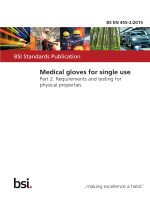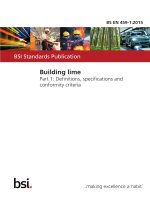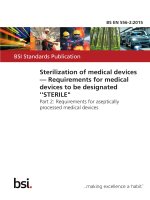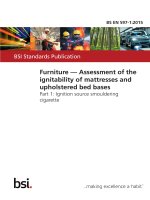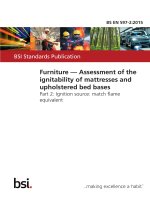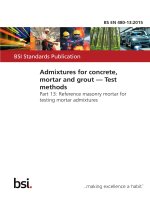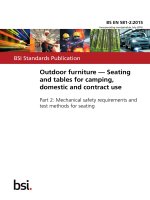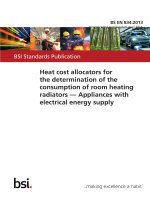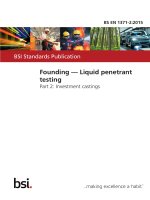Bsi bs en 61010 031 2015
Bạn đang xem bản rút gọn của tài liệu. Xem và tải ngay bản đầy đủ của tài liệu tại đây (2.67 MB, 94 trang )
BS EN 61010-031:2015
BSI Standards Publication
Safety requirements for
electrical equipment for
measurement, control
and laboratory use
Part 031: Safety requirements for
hand-held probe assemblies for
electrical measurement and test
BRITISH STANDARD
BS EN 61010-031:2015
National foreword
This British Standard is the UK implementation of EN 61010-031:2015. It is
identical to IEC 61010-031:2015. It supersedes BS EN 61010-031:2002+A1:
2008, which will be withdrawn on 3 July 2018.
The UK participation in its preparation was entrusted to Technical
Committee EPL/66, Safety of measuring, control and laboratory
equipment.
A list of organizations represented on this committee can be obtained on
request to its secretary.
This publication does not purport to include all the necessary provisions of
a contract. Users are responsible for its correct application.
© The British Standards Institution 2015.
Published by BSI Standards Limited 2015
ISBN 978 0 580 74989 6
ICS 11.080.10; 19.080; 71.040.20
Compliance with a British Standard cannot confer immunity from
legal obligations.
This British Standard was published under the authority of the
Standards Policy and Strategy Committee on 31 August 2015.
Amendments/corrigenda issued since publication
Date
Text affected
BS EN 61010-031:2015
EUROPEAN STANDARD
EN 61010-031
NORME EUROPÉENNE
EUROPÄISCHE NORM
July 2015
ICS 19.080
Supersedes EN 61010-031:2002
English Version
Safety requirements for electrical equipment for measurement,
control and laboratory use - Part 031: Safety requirements for
hand-held probe assemblies for electrical measurement and test
(IEC 61010-031:2015)
Règles de sécurité pour appareils électriques de mesurage,
de régulation et de laboratoire - Partie 031: Exigences de
sécurité pour sondes équipées tenues à la main pour
mesurage et essais électriques
(IEC 61010-031:2015)
Sicherheitsbestimmungen für elektrische Mess-, Steuer-,
Regel- und Laborgeräte - Teil 031:
Sicherheitsbestimmungen für handgehaltenes
Messzubehör zum Messen und Prüfen
(IEC 61010-031:2015)
This European Standard was approved by CENELEC on 2015-07-03. CENELEC members are bound to comply with the CEN/CENELEC
Internal Regulations which stipulate the conditions for giving this European Standard the status of a national standard without any alteration.
Up-to-date lists and bibliographical references concerning such national standards may be obtained on application to the CEN-CENELEC
Management Centre or to any CENELEC member.
This European Standard exists in three official versions (English, French, German). A version in any other language made by translation
under the responsibility of a CENELEC member into its own language and notified to the CEN-CENELEC Management Centre has the
same status as the official versions.
CENELEC members are the national electrotechnical committees of Austria, Belgium, Bulgaria, Croatia, Cyprus, the Czech Republic,
Denmark, Estonia, Finland, Former Yugoslav Republic of Macedonia, France, Germany, Greece, Hungary, Iceland, Ireland, Italy, Latvia,
Lithuania, Luxembourg, Malta, the Netherlands, Norway, Poland, Portugal, Romania, Slovakia, Slovenia, Spain, Sweden, Switzerland,
Turkey and the United Kingdom.
European Committee for Electrotechnical Standardization
Comité Européen de Normalisation Electrotechnique
Europäisches Komitee für Elektrotechnische Normung
CEN-CENELEC Management Centre: Avenue Marnix 17, B-1000 Brussels
© 2015 CENELEC All rights of exploitation in any form and by any means reserved worldwide for CENELEC Members.
Ref. No. EN 61010-031:2015 E
BS EN 61010-031:2015
EN 61010-031:2015
European foreword
The text of document 66/569/FDIS, future edition 2 of IEC 61010-031, prepared by IEC/TC 66 "Safety
of measuring, control and laboratory equipment" was submitted to the IEC-CENELEC parallel vote
and approved by CENELEC as EN 61010-031:2015.
The following dates are fixed:
•
latest date by which the document has to be
implemented at national level by
publication of an identical national
standard or by endorsement
(dop)
2016-04-03
•
latest date by which the national
standards conflicting with the
document have to be withdrawn
(dow)
2018-07-03
This document supersedes EN 61010-031:2002.
Attention is drawn to the possibility that some of the elements of this document may be the subject of
patent rights. CENELEC [and/or CEN] shall not be held responsible for identifying any or all such
patent rights.
This standard covers the Principle Elements of the Safety Objectives for Electrical Equipment
Designed for Use within Certain Voltage Limits (LVD - 2006/95/EC).
Endorsement notice
The text of the International Standard IEC 61010-031:2015 was approved by CENELEC as a
European Standard without any modification.
In the official version, for Bibliography, the following notes have to be added for the standards
indicated:
2
IEC 60065
NOTE
Harmonized as EN 60065.
IEC 60270
NOTE
Harmonized as EN 60270.
IEC 60364-4-44
NOTE
Harmonized as HD 60634-4-44.
IEC 60664-1
NOTE
Harmonized as EN 60664-1.
IEC 60664-3:2003
NOTE
Harmonized as EN 60664-3:2003.
IEC 60664-3:2003/AMD1:2010
NOTE
Harmonized as EN 60664-3:2003/A1:2010.
IEC 60664-4:2005
NOTE
Harmonized as EN 60664-4:2006.
IEC 60990
NOTE
Harmonized as EN 60990.
IEC 61010 (series)
NOTE
Harmonized as EN 61010 (series).
IEC 61032:1997
NOTE
Harmonized as EN 61032:1998.
BS EN 61010-031:2015
EN 61010-031:2015
Annex ZA
(normative)
Normative references to international publications
with their corresponding European publications
The following documents, in whole or in part, are normatively referenced in this document and are
indispensable for its application. For dated references, only the edition cited applies. For undated
references, the latest edition of the referenced document (including any amendments) applies.
NOTE 1 When an International Publication has been modified by common modifications, indicated by (mod), the relevant EN/HD
applies.
NOTE 2 Up-to-date information on the latest versions of the European Standards listed in this annex is available here:
www.cenelec.eu.
Publication
IEC 60027
Year
series
IEC 60529
-
IEC 61010-1
2010
IEC 61180-1
1992
IEC 61180-2
-
IEC Guide 104
-
ISO/IEC Guide 51
-
Title
Letter symbols to be used in electrical
technology
Degrees of protection provided by
enclosures (IP Code)
Safety requirements for electrical
equipment for measurement, control and
laboratory use -- Part 1: General
requirements
High-voltage test techniques for lowvoltage equipment -- Part 1: Definitions,
test and procedure requirements
High-voltage test techniques for lowvoltage equipment -- Part 2: Test
equipment
The preparation of safety publications and
the use of basic safety publications and
group safety publications
Safety aspects - Guidelines for their
inclusion in standards
EN/HD
EN 60027
Year
series
-
-
EN 61010-1
2010
EN 61180-1
1994
EN 61180-2
-
-
-
-
-
3
–2–
BS EN 61010-031:2015
IEC 61010-031:2015 © IEC 2015
CONTENTS
FOREWORD ........................................................................................................................... 7
1
Scope and object ........................................................................................................... 10
1.1
Scope ................................................................................................................... 10
1.1.1
Probe assemblies included in scope .............................................................. 10
1.1.2
Probe assemblies excluded from scope ......................................................... 13
1.2
Object ................................................................................................................... 13
1.2.1
Aspects included in scope ............................................................................. 13
1.2.2
Aspects excluded from scope ........................................................................ 13
1.3
Verification............................................................................................................ 13
1.4
Environmental conditions ...................................................................................... 13
1.4.1
Normal environmental conditions ................................................................... 13
1.4.2
Extended environmental conditions ............................................................... 13
2
Normative references .................................................................................................... 14
3
Terms and definitions .................................................................................................... 14
3.1
Parts and accessories ........................................................................................... 14
3.2
Quantities ............................................................................................................. 15
3.3
Tests .................................................................................................................... 16
3.4
Safety terms ......................................................................................................... 16
3.5
Insulation .............................................................................................................. 17
4
Tests ............................................................................................................................. 18
4.1
General ................................................................................................................. 18
4.2
Sequence of tests ................................................................................................. 19
4.3
Reference test conditions...................................................................................... 19
4.3.1
Environmental conditions ............................................................................... 19
4.3.2
State of probe assemblies .............................................................................. 19
4.3.3
Position of the probe assembly ...................................................................... 19
4.3.4
Accessories ................................................................................................... 20
4.3.5
Covers and removable parts .......................................................................... 20
4.3.6
Input and output voltages .............................................................................. 20
4.3.7
Controls ......................................................................................................... 20
4.3.8
Connections .................................................................................................. 20
4.3.9
Duty cycle ...................................................................................................... 20
4.4
Testing in SINGLE FAULT CONDITION ......................................................................... 20
4.4.1
General ......................................................................................................... 20
4.4.2
Application of fault conditions ........................................................................ 20
4.4.3
Duration of tests ............................................................................................ 21
4.4.4
Conformity after application of fault conditions ............................................... 21
4.5
Tests in REASONABLY FORESEEABLE MISUSE ............................................................ 22
4.5.1
General ......................................................................................................... 22
4.5.2
Fuses ............................................................................................................ 22
5
Marking and documentation ........................................................................................... 22
5.1
Marking ................................................................................................................. 22
5.1.1
General ......................................................................................................... 22
5.1.2
Identification .................................................................................................. 22
5.1.3
Fuses ............................................................................................................ 23
5.1.4
C ONNECTORS and operating devices ............................................................... 24
BS EN 61010-031:2015
IEC 61010-031:2015 © IEC 2015
–3–
5.1.5
R ATING ........................................................................................................... 24
5.2
Warning markings ................................................................................................. 24
5.3
Durability of markings ........................................................................................... 24
5.4
Documentation ...................................................................................................... 25
5.4.1
General ......................................................................................................... 25
5.4.2
Probe assembly RATING ................................................................................. 25
5.4.3
Probe assembly operation ............................................................................. 25
5.4.4
Probe assembly maintenance and service ..................................................... 26
6
Protection against electric shock ................................................................................... 26
6.1
6.2
6.2.1
6.2.2
6.2.3
6.3
6.3.1
6.3.2
6.3.3
6.3.4
6.4
6.4.1
6.4.2
6.4.3
6.4.4
6.4.5
6.4.6
General ................................................................................................................. 26
Determination of ACCESSIBLE parts ........................................................................ 27
General ......................................................................................................... 27
Examination ................................................................................................... 27
Openings for pre-set controls ......................................................................... 28
Limit values for ACCESSIBLE parts .......................................................................... 28
General ......................................................................................................... 28
Levels in NORMAL CONDITION ........................................................................... 29
Levels in SINGLE FAULT CONDITION ................................................................... 29
Measurement of voltage and touch current .................................................... 31
Means of protection against electric shock ............................................................ 34
General ......................................................................................................... 34
C ONNECTORS .................................................................................................. 35
P ROBE TIPS ..................................................................................................... 36
Impedance ..................................................................................................... 38
P ROTECTIVE IMPEDANCE .................................................................................. 38
B ASIC INSULATION , SUPPLEMENTARY INSULATION , DOUBLE INSULATION and
REINFORCED INSULATION .................................................................................. 39
6.5
Insulation requirements ......................................................................................... 39
6.5.1
The nature of insulation ................................................................................. 39
6.5.2
Insulation requirements for probe assemblies ................................................ 44
6.6
Procedure for voltage tests ................................................................................... 50
6.6.1
General ......................................................................................................... 50
6.6.2
Humidity preconditioning ............................................................................... 50
6.6.3
Conduct of tests ............................................................................................ 50
6.6.4
Test voltages ................................................................................................. 51
6.6.5
Test procedures ............................................................................................. 53
6.7
Constructional requirements for protection against electric shock ......................... 54
6.7.1
General ......................................................................................................... 54
6.7.2
Insulating materials ....................................................................................... 54
6.7.3
E NCLOSURES of probe assemblies with DOUBLE INSULATION or REINFORCED
INSULATION ..................................................................................................... 54
6.7.4
P ROBE WIRE attachment ................................................................................. 54
7
Protection against mechanical HAZARDS ......................................................................... 58
8
Resistance to mechanical stresses ................................................................................ 58
8.1
General ................................................................................................................. 58
8.2
Rigidity test ........................................................................................................... 59
8.3
Drop test ............................................................................................................... 59
8.4
Impact swing test .................................................................................................. 59
9
Temperature limits and protection against the spread of fire .......................................... 60
–4–
BS EN 61010-031:2015
IEC 61010-031:2015 © IEC 2015
9.1
General ................................................................................................................. 60
9.2
Temperature tests ................................................................................................. 61
10 Resistance to heat ......................................................................................................... 61
10.1 Integrity of SPACINGS ............................................................................................. 61
10.2 Resistance to heat ................................................................................................ 61
11 Protection against HAZARDS from fluids .......................................................................... 61
11.1 General ................................................................................................................. 61
11.2 Cleaning ............................................................................................................... 61
11.3 Specially protected probe assemblies ................................................................... 62
12 Components .................................................................................................................. 62
12.1 General ................................................................................................................. 62
12.2 Fuses.................................................................................................................... 62
12.3 P ROBE WIRE ........................................................................................................... 63
12.3.1
General ......................................................................................................... 63
12.3.2
R ATING of PROBE WIRE .................................................................................... 63
12.3.3
Pressure test at high temperature for insulations ........................................... 63
12.3.4
Tests for resistance of insulation to cracking ................................................. 65
12.3.5
Voltage test ................................................................................................... 65
12.3.6
Tensile test .................................................................................................... 66
13 Prevention of HAZARD from arc flash and short-circuits ................................................... 68
13.1 General ................................................................................................................. 68
13.2 Exposed conductive parts ..................................................................................... 68
Annex A (normative) Measuring circuits for touch current (see 6.3) ...................................... 69
A.1
A.2
Measuring circuits for a.c. with frequencies up to 1 MHz and for d.c. .................... 69
Measuring circuits for a.c. with sinusoidal frequencies up to 100 Hz and for
d.c. ....................................................................................................................... 69
A.3
Current measuring circuit for electrical burns at frequencies above 100 kHz ......... 70
A.4
Current measuring circuit for WET LOCATIONS ......................................................... 71
Annex B (normative) Standard test fingers ........................................................................... 73
Annex C (normative) Measurement of CLEARANCES and CREEPAGE DISTANCES ....................... 76
Annex D (normative) Routine spark tests on PROBE WIRE ...................................................... 78
D.1
D.2
D.3
Annex E
General ................................................................................................................. 78
Spark test procedure ............................................................................................. 78
Routine spark test method for PROBE WIRE ............................................................ 80
(informative) 4 mm CONNECTORS ........................................................................... 82
E.1
General ................................................................................................................. 82
E.2
Dimensions ........................................................................................................... 82
Annex F (normative) M EASUREMENT C ATEGORIES .................................................................. 84
F.1
General ................................................................................................................. 84
F.2
M EASUREMENT CATEGORIES .................................................................................... 84
F.2.1
M EASUREMENT CATEGORY II ............................................................................. 84
F.2.2
M EASUREMENT CATEGORY III ............................................................................ 84
F.2.3
M EASUREMENT CATEGORY IV ........................................................................... 84
F.2.4
Probe assemblies without a MEASUREMENT CATEGORY RATING .......................... 85
Annex G Index of defined terms ............................................................................................ 86
Bibliography .......................................................................................................................... 87
BS EN 61010-031:2015
IEC 61010-031:2015 © IEC 2015
–5–
Figure 1 – Examples of type A probe assemblies .................................................................. 11
Figure 2 – Examples of type B probe assemblies .................................................................. 11
Figure 3 – Examples of type C probe assemblies .................................................................. 12
Figure 4 – Examples of type D probe assemblies .................................................................. 12
Figure 5 – Example of a STACKABLE CONNECTOR with a male CONNECTOR and a female
TERMINAL ............................................................................................................................... 15
Figure 6 – Methods for determination of ACCESSIBLE parts (see 6.2) and for voltage
tests of (see 6.4.2) ................................................................................................................ 28
Figure 7 – Capacitance level versus voltage in NORMAL CONDITION and SINGLE - FAULT
(see 6.3.2 c) and 6.3.3 c)) .................................................................................... 30
CONDITION
Figure 8 – Voltage and touch current measurement .............................................................. 31
Figure 9 – Voltage and touch current measurement for the reference CONNECTOR ................. 32
Figure 10 – Voltage and touch current measurement with shielded test probe ...................... 33
Figure 11 – Maximum test probe input voltage for 70 mA touch current................................. 34
Figure 12 – Protection by a PROTECTIVE FINGERGUARD ........................................................... 37
Figure 13 – Protection by distance ........................................................................................ 37
Figure 14 – Protection by tactile indicator ............................................................................. 38
Figure 15 – Distance between conductors on an interface between two layers ...................... 42
Figure 16 – Distance between adjacent conductors along an interface of two layers ............ 42
Figure 17 – Distance between adjacent conductors located between the same two
layers.................................................................................................................................... 44
Figure 18 – Example of recurring peak voltage ..................................................................... 47
Figure 19 – Flexing test ........................................................................................................ 56
Figure 20 – Rotational flexing test ......................................................................................... 58
Figure 21 – Impact swing test ............................................................................................... 60
Figure 22 – Indentation device .............................................................................................. 64
Figure A.1 – Measuring circuit for a.c. with frequencies up to 1 MHz and for d.c. .................. 69
Figure A.2 – Measuring circuits for a.c. with sinusoidal frequencies up to 100 Hz and
for d.c. .................................................................................................................................. 70
Figure A.3 – Current measuring circuit for electrical burns .................................................... 71
Figure A.4 – Current measuring circuit for high frequency test probes ................................... 71
Figure A.5 – Current measuring circuit for WET LOCATIONS ..................................................... 72
Figure B.1 – Rigid test finger ................................................................................................ 73
Figure B.2 – Jointed test finger ............................................................................................. 74
Figure D.1 – Bead Chain Configuration (if applicable) ........................................................... 79
Figure E.1 – Recommended dimensions of 4 mm CONNECTORS ............................................. 82
Figure F.1 – Example to identify the locations of MEASUREMENT CATEGORIES .......................... 85
Table 1 – Symbols ................................................................................................................ 23
Table 2 – S PACINGS for unmated CONNECTORS RATED up to 1 000 V a.c. or 1 500 V d.c.
with HAZARDOUS LIVE conductive parts ................................................................................... 36
Table 3 – Multiplication factors for CLEARANCES of probe assembly RATED for operation
at altitudes up to 5 000 m ..................................................................................................... 40
Table 4 – Test voltages for testing solid insulation ................................................................ 41
Table 5 – Minimum values for distance or thickness .............................................................. 43
–6–
BS EN 61010-031:2015
IEC 61010-031:2015 © IEC 2015
Table 6 – C LEARANCES for probe assemblies of MEASUREMENT CATEGORIES II, III and IV ........ 44
Table 7 – C LEARANCE values for the calculation of 6.5.2.3.2 .................................................. 46
Table 8 – C LEARANCES for BASIC INSULATION in probe assemblies subjected to recurring
peak voltages or WORKING VOLTAGES with frequencies above 30 kHz ..................................... 48
Table 9 – C REEPAGE DISTANCES for BASIC INSULATION or SUPPLEMENTARY INSULATION .............. 49
Table 10 – Test voltages based on CLEARANCES .................................................................... 52
Table 11 – Correction factors according to test site altitude for test voltages for
CLEARANCES .......................................................................................................................... 53
Table 12 – Pull forces for PROBE WIRE attachment tests ......................................................... 57
Table 13 – Diameter of mandrel and numbers of turns .......................................................... 65
Table C.1 – Dimension of X .................................................................................................. 76
Table D.1 – Maximum centre-to-centre spacings of bead chains ........................................... 78
Table D.2 – Formula for maximum speed of wire in terms of electrode length L of linkor bead-chain electrode ........................................................................................................ 80
Table F.1 – Characteristics of MEASUREMENT CATEGORIES ...................................................... 85
BS EN 61010-031:2015
IEC 61010-031:2015 © IEC 2015
–7–
INTERNATIONAL ELECTROTECHNICAL COMMISSION
____________
SAFETY REQUIREMENTS FOR ELECTRICAL EQUIPMENT
FOR MEASUREMENT, CONTROL AND LABORATORY USE –
Part 031: Safety requirements for hand-held
probe assemblies for electrical measurement and test
FOREWORD
1) The International Electrotechnical Commission (IEC) is a worldwide organization for standardization comprising
all national electrotechnical committees (IEC National Committees). The object of IEC is to promote
international co-operation on all questions concerning standardization in the electrical and electronic fields. To
this end and in addition to other activities, IEC publishes International Standards, Technical Specifications,
Technical Reports, Publicly Available Specifications (PAS) and Guides (hereafter referred to as “IEC
Publication(s)”). Their preparation is entrusted to technical committees; any IEC National Committee interested
in the subject dealt with may participate in this preparatory work. International, governmental and nongovernmental organizations liaising with the IEC also participate in this preparation. IEC collaborates closely
with the International Organization for Standardization (ISO) in accordance with conditions determined by
agreement between the two organizations.
2) The formal decisions or agreements of IEC on technical matters express, as nearly as possible, an international
consensus of opinion on the relevant subjects since each technical committee has representation from all
interested IEC National Committees.
3) IEC Publications have the form of recommendations for international use and are accepted by IEC National
Committees in that sense. While all reasonable efforts are made to ensure that the technical content of IEC
Publications is accurate, IEC cannot be held responsible for the way in which they are used or for any
misinterpretation by any end user.
4) In order to promote international uniformity, IEC National Committees undertake to apply IEC Publications
transparently to the maximum extent possible in their national and regional publications. Any divergence
between any IEC Publication and the corresponding national or regional publication shall be clearly indicated in
the latter.
5) IEC itself does not provide any attestation of conformity. Independent certification bodies provide conformity
assessment services and, in some areas, access to IEC marks of conformity. IEC is not responsible for any
services carried out by independent certification bodies.
6) All users should ensure that they have the latest edition of this publication.
7) No liability shall attach to IEC or its directors, employees, servants or agents including individual experts and
members of its technical committees and IEC National Committees for any personal injury, property damage or
other damage of any nature whatsoever, whether direct or indirect, or for costs (including legal fees) and
expenses arising out of the publication, use of, or reliance upon, this IEC Publication or any other IEC
Publications.
8) Attention is drawn to the Normative references cited in this publication. Use of the referenced publications is
indispensable for the correct application of this publication.
9) Attention is drawn to the possibility that some of the elements of this IEC Publication may be the subject of
patent rights. IEC shall not be held responsible for identifying any or all such patent rights.
International Standard IEC 61010-031 has been prepared by IEC technical committee 66:
Safety of measuring, control and laboratory equipment.
It has the status of a group safety publication in accordance with IEC GUIDE 104.
IEC 61010-031 is a stand-alone standard. This second edition cancels and replaces the first
edition published in 2002 and Amendment 1:2008. This edition constitutes a technical
revision.
This edition includes the following significant changes from the first edition, as well as
numerous other changes:
a) Voltages above the levels of 30 V r.m.s., 42,4 V peak, or 60 V d.c. are deemed to be
HAZARDOUS LIVE instead of 33 V r.m.s., 46,7 V peak, or 70 V d.c.
BS EN 61010-031:2015
IEC 61010-031:2015 © IEC 2015
–8–
b) Servicing is now included within the scope.
c) Extended environmental conditions are included within the scope.
d) New terms have been defined.
e) Tests for REASONABLY FORESEEABLE MISUSE have been added, in particular for fuses.
f)
Additional instruction requirements for probe assembly operation have been specified.
g) Limit values for ACCESSIBLE parts and for measurement of voltage and touch current have
been modified.
h) S PACINGS requirements for mating of CONNECTORS have been modified.
i)
P ROBE TIPS and SPRING - LOADED CLIPS requirements have been modified. The PROTECTIVE
FINGERGUARD replace the BARRIER with new requirements.
j)
Insulation requirements (6.5) and test procedures (6.6.5) have been rewritten and aligned
when relevant with Part 1. Specific requirements have been added for solid insulation and
thin-film insulation.
k) The terminology for MEASUREMENT CATEGORY I has been replaced with the designation “not
RATED for measurements within MEASUREMENT CATEGORIES II, III, or IV”.
l)
The flexing/pull test (6.7.4.3) has been partially rewritten.
m) Surface temperature limits (Clause 10) have been modified to conform to the limits of IEC
Guide 117.
n) Requirements for resistance of PROBE WIRES to mechanical stresses have been added in
Clause 12 and a new Annex D.
o) Requirements have been added regarding the prevention of HAZARD from arc flash and
short-circuits for SPRING - LOADED CLIPS .
p) A new informative Annex E defines the dimension of the 4 mm banana CONNECTORS .
The text of this standard is based on the following documents:
FDIS
Report on voting
66/569/FDIS
66/571/RVD
Full information on the voting for the approval of this standard can be found in the report on
voting indicated in the above table.
This publication has been drafted in accordance with the ISO/IEC Directives, Part 2.
A list of all parts of the IEC 61010 series, under the general title, Safety requirements for
electrical equipment for measurement, control, and laboratory use, may be found on the IEC
website.
In this standard, the following print types are used:
–
requirements and definitions: in roman type;
–
NOTES and EXAMPLES: in smaller roman type;
–
conformity and tests: in italic type;
–
terms used throughout this standard which have been defined in Clause 3: SMALL ROMAN
CAPITALS .
BS EN 61010-031:2015
IEC 61010-031:2015 © IEC 2015
–9–
The committee has decided that the contents of this publication will remain unchanged until
the stability date indicated on the IEC web site under "" in the data
related to the specific publication. At this date, the publication will be
•
reconfirmed,
•
withdrawn,
•
replaced by a revised edition, or
•
amended.
IMPORTANT – The 'colour inside' logo on the cover page of this publication indicates
that it contains colours which are considered to be useful for the correct
understanding of its contents. Users should therefore print this document using a
colour printer.
– 10 –
BS EN 61010-031:2015
IEC 61010-031:2015 © IEC 2015
SAFETY REQUIREMENTS FOR ELECTRICAL EQUIPMENT
FOR MEASUREMENT, CONTROL AND LABORATORY USE –
Part 031: Safety requirements for hand-held
probe assemblies for electrical measurement and test
1
Scope and object
1.1
1.1.1
Scope
Probe assemblies included in scope
This part of IEC 61010 specifies safety requirements for hand-held and hand-manipulated
probe assemblies of the types described below, and their related accessories. These probe
assemblies are for direct electrical connection between a part and electrical test and
measurement equipment. They may be fixed to the equipment or be detachable accessories
for the equipment.
a) Type A: low-voltage and high-voltage, non-attenuating probe assemblies. Non-attenuating
probe assemblies that are RATED for direct connection to voltages exceeding 30 V r.m.s.,
42,4 V peak, or 60 V d.c., but not exceeding 63 kV. They do not incorporate components
which are intended to provide a voltage divider function or a signal conditioning function,
but they may contain non-attenuating components such as fuses (see Figure 1.)
b) Type B: high-voltage attenuating or divider probe assemblies. Attenuating or divider probe
assemblies that are RATED for direct connection to secondary voltages exceeding
1 kV r.m.s. or 1,5 kV d.c. but not exceeding 63 kV r.m.s. or d.c. The divider function may
be carried out wholly within the probe assembly, or partly within the test or measurement
equipment to be used with the probe assembly (see Figure 2).
c) Type C: low-voltage attenuating or divider probe assemblies. Attenuating or divider probe
assemblies for direct connection to voltages not exceeding 1 kV r.m.s. or 1,5 kV d.c. The
signal conditioning function may be carried out wholly within the probe assembly, or partly
within the test or measurement equipment intended to be used with the probe assembly
(see Figure 3).
d) Type D: low-voltage attenuating, non-attenuating or other signal conditioning probe
assemblies, that are RATED for direct connection only to voltages not exceeding
30 V r.m.s., or 42,4 V peak, or 60 V d.c., and are suitable for currents exceeding 8 A (see
Figure 4).
BS EN 61010-031:2015
IEC 61010-031:2015 © IEC 2015
– 11 –
5
1
2
3
6
1
4
IEC
Key
1
typical CONNECTORS
4
to equipment
2
PROBE TIP
5
SPRING - LOADED CLIP
3
probe body
6
PROBE W IRE
Figure 1 – Examples of type A probe assemblies
1
4
5
6
2
3
1
4
5
6
3
2
IEC
Key
1
PROBE TIP
4
PROTECTIVE FINGERGUARD
2
to equipment
5
hand-held area of probe body
3
reference CONNECTOR
6
PROBE W IRE
Figure 2 – Examples of type B probe assemblies
BS EN 61010-031:2015
IEC 61010-031:2015 © IEC 2015
– 12 –
6
3
2
1
6
4
7
5
IEC
Key
1
PROBE TIP
5
PROBE W IRE
2
probe body
6
examples of accessories
3
reference CONNECTOR
7
BNC CONNECTOR
4
to equipment
Figure 3 – Examples of type C probe assemblies
1
3
1
4
2
3
3
2
4
1
IEC
Key
1
CONNECTOR
3
hand-held area of SPRING - LOADED CLIP or clamp
2
PROBE TIP
4
PROBE W IRE
Figure 4 – Examples of type D probe assemblies
BS EN 61010-031:2015
IEC 61010-031:2015 © IEC 2015
1.1.2
– 13 –
Probe assemblies excluded from scope
This standard does not apply to current sensors within the scope of IEC 61010-2-032 (Handheld and hand-manipulated current sensors), but may apply to their input measuring circuit
leads and accessories.
1.2
Object
1.2.1
Aspects included in scope
The purpose of the requirements of this standard is to ensure that HAZARDS to the OPERATOR
and the surrounding area are reduced to a tolerable level.
Requirements for protection against particular types of HAZARDS are given in Clauses 6 to 13,
as follows:
a) electric shock or burn (see Clauses 6, 10 and 11);
b) mechanical HAZARDS (see Clauses 7, 8 and 11);
c) excessive temperature (see Clause 9);
d) spread of fire from the probe assembly (see Clause 9);
e) arc flash (see Clause 13).
Additional requirements for probe assemblies which are designed to be powered from a lowvoltage mains supply, or include other features not specifically addressed in this standard are
in other parts of IEC 61010.
NOTE Attention is drawn to the possible existence of additional requirements regarding the health and safety of
labour forces.
1.2.2
Aspects excluded from scope
This standard does not cover:
a) reliable function, performance, or other properties of the probe assembly;
b) effectiveness of transport packaging.
1.3
Verification
This standard also specifies methods of verifying that the probe assembly meets the
requirements of this standard, through inspection, TYPE TESTS , and ROUTINE TESTS .
1.4
Environmental conditions
1.4.1
Normal environmental conditions
This standard applies to probe assemblies designed to be safe at least under the following
conditions:
a)
altitude up to 2 000 m;
b)
ambient temperature of 5 °C to 40 °C;
c)
maximum relative humidity of 80 % for temperatures up to 31 °C decreasing linearly to
50 % relative humidity at 40 °C;
d)
applicable POLLUTION DEGREE of the intended environment.
1.4.2
Extended environmental conditions
This standard applies to probe assemblies designed to be safe not only in the environmental
conditions specified in 1.4.1, but also in any of the following conditions as RATED by the
manufacturer of the probe assemblies:
– 14 –
a)
outdoor use;
b)
altitudes above 2 000 m;
c)
ambient temperatures below 5 °C or above 40 °C;
d)
e)
relative humidities above the levels specified in 1.4.1;
WET LOCATIONS .
2
Normative references
BS EN 61010-031:2015
IEC 61010-031:2015 © IEC 2015
The following documents, in whole or in part, are normatively referenced in this document and
are indispensable for its application. For dated references, only the edition cited applies. For
undated references, the latest edition of the referenced document (including any
amendments) applies.
IEC 60027 (all parts), Letters symbols to be used in electrical technology
IEC 60529, Degrees of protection provided by enclosures (IP Code)
IEC 61010-1:2010, Safety requirements for electrical equipment for measurement, control,
and laboratory use – Part 1: General requirements
IEC 61180-1:1992, High-voltage test techniques for low voltage equipment – Part 1:
Definitions, test and procedure requirements
IEC 61180-2, High-voltage test techniques for low-voltage equipment – Part 2: Test
equipment
IEC GUIDE 104, The preparation of safety publications and the use of basic safety
publications and group safety publications
ISO/IEC GUIDE 51, Safety aspects – Guidelines for their inclusion in standards
3
Terms and definitions
For the purposes of this document, the following terms and definitions apply.
3.1
Parts and accessories
3.1.1
TERMINAL
component provided for the connection of a device (equipment) to external conductors
Note 1 to entry:
etc.
T ERMINALS can contain one or several contacts and the term includes sockets, pins, connectors,
3.1.2
ENCLOSURE
part providing protection of a probe assembly against certain external influences and, in any
direction, protection against direct contact
3.1.3
PROTECTIVE FINGERGUARD
part of the ENCLOSURE that indicates the
OPERATOR touching HAZARDOUS LIVE parts
limit of safe access and that reduces the risk of the
BS EN 61010-031:2015
IEC 61010-031:2015 © IEC 2015
– 15 –
3.1.4
PROBE TIP
part of a probe assembly or accessory which makes a connection to the point being measured
or tested
Note 1 to entry:
The term “ PROBE TIP ” includes the conductive parts of the jaws or hooks of SPRING - LOADED CLIPS .
3.1.5
CONNECTOR
component which is attached to the PROBE WIRE , to connect to a TERMINAL of the equipment or
to a CONNECTOR of another probe assembly
3.1.6
TOOL
external device, including a key or coin, used to aid a person performing a mechanical
function
3.1.7
PROBE WIRE
flexible wire or cable used as part of the probe assembly or its accessories, consisting of one
or more conductors and associated insulation
3.1.8
SPRING - LOADED CLIP
probe or probe accessory with one or more hooks or jaws forced by a spring to grip the part
being measured or tested
3.1.9
STACKABLE CONNECTOR
CONNECTOR assembly which
EXAMPLE:
contains an additional TERMINAL
Figure 5 is an example of a STACKABLE CONNECTOR with a male CONNECTOR and a female TERMINAL .
2
1
3
IEC
Key
1
T ERMINAL for additional CONNECTOR
2
C ONNECTOR
3
P ROBE W IRE
Figure 5 – Example of a STACKABLE CONNECTOR
with a male CONNECTOR and a female TERMINAL
3.2
3.2.1
Quantities
RATED (condition or value)
condition or quantity value assigned, generally by a manufacturer, for a specified operating
condition of a component, device, or probe assembly
– 16 –
BS EN 61010-031:2015
IEC 61010-031:2015 © IEC 2015
3.2.2
RATING
set of RATED
values and operating conditions
[SOURCE: IEC 60050-151:2001, 151-16-11]
3.2.3
WORKING VOLTAGE
highest r.m.s. value of the a.c. or d.c. voltage across any particular insulation which can
continuously appear during NORMAL USE
Note 1 to entry:
3.3
Transients and voltage fluctuations are not considered to be part of the WORKING VOLTAGE
Tests
3.3.1
TYPE TEST
test of one or more samples of a probe assembly (or parts of a probe assembly) made to a
particular design, to show that the design and construction meet the requirements of this
standard
Note 1 to entry:
as construction.
This is an amplification of the IEC 60050-151:2001, 151-16-16 definition to cover design as well
3.3.2
ROUTINE TEST
conformity test made on each individual item during or after manufacture
[SOURCE: IEC 60050-151:2001, 151-16-17]
3.4
Safety terms
3.4.1
ACCESSIBLE
able to be touched with a standard test finger or test pin, when used as specified in 6.2
3.4.2
HAZARDOUS LIVE
capable of rendering an electric shock or electric burn
3.4.3
HAZARD
potential source of harm
3.4.4
PROTECTIVE IMPEDANCE
component or assembly of components whose impedance, construction and reliability are
suitable to provide protection against electric shock
3.4.5
NORMAL USE
operation, including stand-by, according to the instructions for use or for the obvious intended
purpose
3.4.6
NORMAL CONDITION
condition in which all means for protection against HAZARDS are intact
BS EN 61010-031:2015
IEC 61010-031:2015 © IEC 2015
– 17 –
3.4.7
SINGLE FAULT CONDITION
condition in which one means for protection against a HAZARD is defective or one fault is
present which could cause a HAZARD
3.4.8
OPERATOR
person operating the probe assembly for its intended purpose
3.4.9
RESPONSIBLE BODY
individual or group responsible for the safe use and maintenance of probe assemblies
3.4.10
WET LOCATION
location where water or another conductive liquid may be present and is likely to cause
reduced human body impedance due to wetting of the contact between the human body and
the probe assembly, or wetting of the contact between the human body and the environment
3.4.11
MEASUREMENT CATEGORY
classification of testing and measuring circuits according to the types of mains circuits to
which they are intended to be connected
3.4.12
REASONABLY FORESEEABLE MISUSE
use of a product in a way not intended by the supplier, but which may result from readily
predictable human behaviour
3.5
Insulation
3.5.1
BASIC INSULATION
insulation of HAZARDOUS LIVE
parts which provides basic protection
[SOURCE: IEC 60050-195:1998, 195-06-06]
3.5.2
SUPPLEMENTARY INSULATION
independent insulation applied in addition to BASIC INSULATION in order to provide protection
against electric shock in the event of a failure of BASIC INSULATION
3.5.3
DOUBLE INSULATION
insulation comprising both BASIC INSULATION and SUPPLEMENTARY INSULATION
[SOURCE: IEC 60050-195:1998, 195-06-08]
3.5.4
REINFORCED INSULATION
insulation which provides a degree of protection against electric shock not less than that
provided by DOUBLE INSULATION
3.5.5
POLLUTION
addition of foreign matter, solid, liquid or gaseous (ionized gases), that may produce a
reduction of dielectric strength or surface resistivity
– 18 –
BS EN 61010-031:2015
IEC 61010-031:2015 © IEC 2015
3.5.6
POLLUTION DEGREE
numeral indicating the level of POLLUTION that may be present in the environment
3.5.7
POLLUTION DEGREE 1
no POLLUTION or only
dry, non-conductive POLLUTION occurs, which has no influence
3.5.8
2
only non-conductive POLLUTION occurs except that occasionally a temporary conductivity
caused by condensation is expected
POLLUTION DEGREE
3.5.9
POLLUTION DEGREE 3
conductive POLLUTION
occurs, or dry, non-conductive POLLUTION occurs which becomes
conductive due to condensation which is expected
3.5.10
CLEARANCE
shortest distance in air between two conductive parts
3.5.11
CREEPAGE DISTANCE
shortest distance along the surface of a solid insulating material between two conductive
parts
[SOURCE: IEC 60050-151:2001, 151-15-50]
3.5.12
SPACING
any combination of CLEARANCES and CREEPAGE DISTANCES
4
4.1
Tests
General
Tests in this standard are TYPE TESTS to be carried out on samples of probe assemblies or
their parts. Their only purpose is to check that the design and construction ensure conformity
with this standard. In addition, the ROUTINE TESTS of Annex D shall be performed on the PROBE
WIRE .
The probe assembly shall at least meet the requirements of this standard. It is permissible to
exceed the requirements. If, in this standard, a lower limit is specified for a conformity value,
then the probe assembly may demonstrate a larger value. If an upper limit is specified for a
conformity value, the probe assembly may demonstrate a lower value. Manufacturing
variations and tolerances shall be taken into account.
Tests on components or parts of the probe assembly meeting the requirements of the relevant
standards specified in this standard, and used in accordance with them, need not be repeated
during TYPE TESTS of the whole probe assembly.
If a probe assembly is of more than one probe type (see 1.1.1), each type shall be tested
according to its applicable requirements.
Conformity with the requirements of this standard is checked by carrying out all applicable
tests, except that a test may be omitted if examination of the probe assembly and design
BS EN 61010-031:2015
IEC 61010-031:2015 © IEC 2015
– 19 –
documentation demonstrates conclusively that it would pass the test. Tests are carried out
both under reference test conditions (see 4.3) and fault conditions (see 4.4).
Where conformity statements in this standard require inspection, this may include examination
of the probe assembly by measurement, examination of the markings on the probe assembly,
examination of the instructions supplied with the probe assembly, examination of the data
sheets of the materials or components from which the probe assembly is manufactured, etc.
In each case, the inspection will either demonstrate that the probe assembly meets the
applicable requirements, or will indicate that further testing is required.
If, when carrying out a conformity test, there is any uncertainty about the exact value of an
applied or measured quantity (for example voltage) due to the tolerance:
a) manufacturers should ensure that at least the specified test value is applied;
b) test houses should ensure that no more than the specified test value is applied.
If the RATED range of environmental conditions for probe assemblies is wider than that stated
in 1.4.1, the manufacturer should make sure (for example, by suitable alteration of test
requirements or additional tests) that the safety requirements of this standard are still fulfilled.
Probe assemblies which have been type tested may no longer be suitable for their intended
function because of the residual effect of stresses resulting from tests. A probe assembly
which has undergone TYPE TESTS shall not then be put into use.
4.2
Sequence of tests
The sequence of tests is optional unless otherwise specified. The probe assemblies under
test shall be carefully inspected after each test. If the result of a test causes doubt whether
any earlier tests would have passed if the sequence had been reversed, these earlier tests
shall be repeated.
4.3
Reference test conditions
4.3.1
Environmental conditions
Unless otherwise specified in this standard, the following environmental conditions (but not
conflicting with those of 1.4.1, shall exist in the test location:
a)
a temperature of 15 °C to 35 °C;
b)
a relative humidity of not more than 75 %;
c)
an air pressure of 75 kPa to 106 kPa;
d)
no hoarfrost, dew, percolating water, rain, solar irradiation, etc.
4.3.2
State of probe assemblies
Unless otherwise specified, tests shall be carried out on the probe assemblies assembled for
and under the least favourable combination of the conditions given in 4.3.3 to
4.3.9.
NORMAL USE
In case of doubt, tests shall be performed in more than one combination of conditions.
If dimensions or mass make it unsuitable to carry out particular tests on a complete probe
assembly, tests on sub-assemblies are allowed, provided it is verified that the assembled
probe assembly will meet the requirements of this standard.
4.3.3
Position of the probe assembly
All possible orientations of the probe assembly are considered to be positions of NORMAL USE .
– 20 –
4.3.4
BS EN 61010-031:2015
IEC 61010-031:2015 © IEC 2015
Accessories
Accessories and OPERATOR -interchangeable parts available from, or recommended by, the
manufacturer for use with the probe assembly under test shall be either connected or not
connected.
4.3.5
Covers and removable parts
Covers or parts which can be removed without using a TOOL shall be removed or not removed
whichever is the worst condition.
4.3.6
Input and output voltages
Input and output voltages, including floating voltages shall be set to any voltage within the
RATED voltage range.
4.3.7
Controls
Controls which the OPERATOR can adjust without the use of a TOOL shall be set to any position
except for combinations of settings prohibited by the manufacturer’s marking on the probe
assembly.
4.3.8
Connections
The probe assembly shall be connected for NORMAL USE or not connected whichever is the
worst condition.
4.3.9
Duty cycle
Probe assemblies for short-term or intermittent operation shall be operated for the longest
period and shall have the shortest RATED recovery period consistent with the
manufacturer's instructions.
RATED
4.4
Testing in SINGLE FAULT CONDITION
4.4.1
General
The following requirements apply.
a) Examination of the probe assembly and its circuit diagram will generally show the fault
conditions which are liable to result in HAZARDS and which, therefore, shall be applied.
b) Fault tests shall be made as specified for checking conformity, unless it can be
demonstrated that no HAZARD could arise from a particular fault condition.
c) The probe assembly shall be operated under the least favourable combination of
reference test conditions (see 4.3). These combinations may be different for different
faults and they shall be recorded for each test.
4.4.2
4.4.2.1
Application of fault conditions
General
Fault conditions shall include those specified in 4.4.2.2 to 4.4.2.5. They shall be applied only
one at a time and shall be applied in turn in the most convenient order. Multiple simultaneous
faults shall not be applied unless they are a consequence of an applied fault.
After each application of a fault condition, the probe assembly or part shall pass the
applicable tests of 4.4.4.
BS EN 61010-031:2015
IEC 61010-031:2015 © IEC 2015
4.4.2.2
– 21 –
P ROTECTIVE IMPEDANCE
The following requirements apply.
a) If a PROTECTIVE IMPEDANCE is formed by a combination of components, each component
shall be short-circuited or disconnected, whichever is less favourable.
b) If a PROTECTIVE IMPEDANCE is formed with a single component that meets the requirements
of 6.4.5, it need not be short-circuited or disconnected.
4.4.2.3
Probe assemblies or parts for short-term or intermittent operation
These shall be operated continuously if continuous operation could occur in a SINGLE FAULT
CONDITION .
4.4.2.4
Outputs
Outputs of Type B and Type C probe assemblies shall be short-circuited.
4.4.2.5
Insulation between circuits and parts
Insulation between circuits and parts which is below the level specified for BASIC INSULATION
shall be bridged to check against the spread of fire if the method of 9.1 is used.
4.4.3
Duration of tests
The probe assembly shall be operated until further change as a result of the applied fault is
unlikely. Each test is normally limited to 1 h since a secondary fault arising from a SINGLE
FAULT CONDITION will usually manifest itself within that time. If there is an indication that a
HAZARD of electric shock, spread of fire or injury to persons may eventually occur, the test
shall be continued for a maximum period of 4 h.
4.4.4
4.4.4.1
Conformity after application of fault conditions
Electric shock
Conformity with requirements for protection against electric shock after the application of
single faults is checked as follows:
a) by making the measurements of 6.3.3 to check that no ACCESSIBLE conductive parts have
become HAZARDOUS LIVE , except as permitted by 6.1;
b) by performing a voltage test on DOUBLE INSULATION or REINFORCED INSULATION to check that
the protection is still at least at the level of BASIC INSULATION . The voltage tests are made
as specified in 6.6 (without humidity preconditioning) with the test voltage for BASIC
INSULATION .
4.4.4.2
Temperature
Conformity with requirements for temperature protection is checked by determining the
temperature of the outer surface of the probe assembly (see Clause 9).
This temperature is determined by measuring the temperature rise of the surface or part and
adding it to the maximum RATED ambient temperature.
4.4.4.3
Spread of fire
Conformity with requirements for protection against the spread of fire is checked by placing
the probe assembly on white tissue-paper covering a softwood surface and covering the
probe assembly with cheesecloth. No molten metal, burning insulation, flaming particles, etc.
shall fall on the surface on which the probe assembly stands and there shall be no charring,
glowing, or flaming of the tissue paper or cheesecloth. Melting of insulation material shall be
ignored if no HAZARD could arise.
